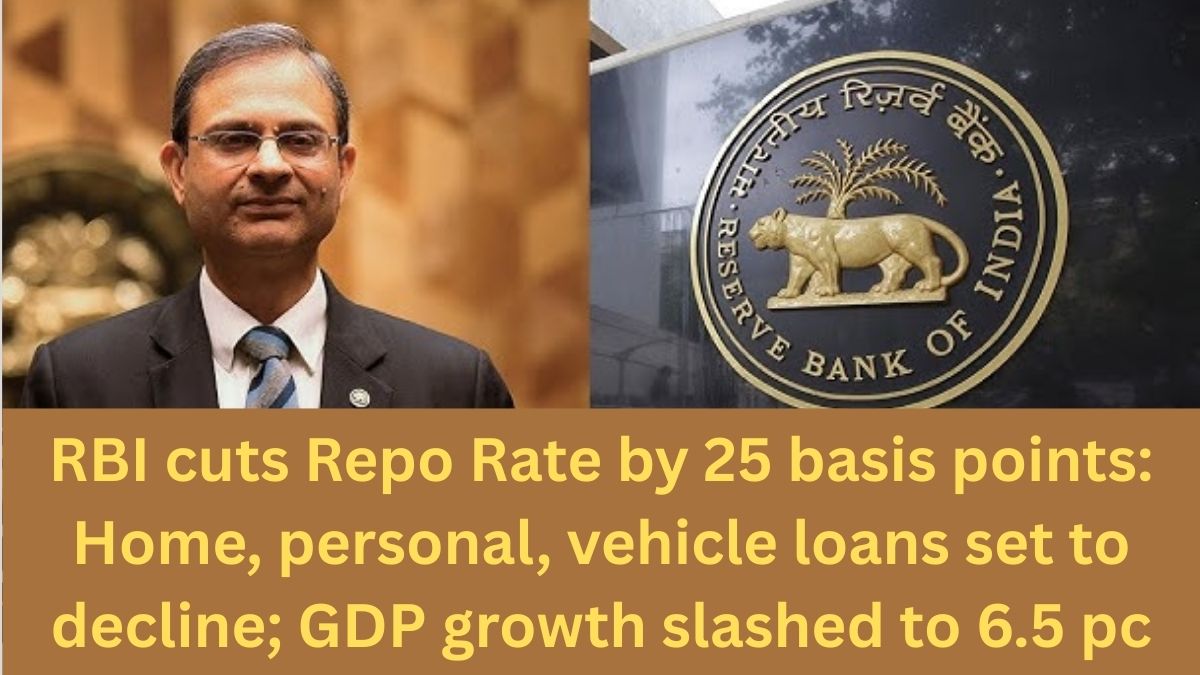In its latest monetary policy review held on April 9, the Reserve Bank of India (RBI) announced a 25 basis point reduction in the repo rate, bringing it down to 6%. This marks the second consecutive rate cut, aimed at making borrowing cheaper amid global uncertainties and moderating inflation. The central bank also shifted its policy stance from “neutral” to “accommodative,” signaling that more rate cuts may follow if necessary.
This move is expected to lead to a downward revision in lending rates for various types of loans—including home, personal, and auto loans—and also impact deposit interest rates. The Monetary Policy Committee (MPC) also revised India’s GDP growth projection downward from 6.7% to 6.5% for FY 2025–26, citing global trade headwinds.
Why the Rate Cut Now? The Global and Domestic Context
The rate cut comes amid a volatile global economic landscape. Recent announcements of reciprocal tariffs by the U.S. have raised concerns about escalating trade tensions and a potential slowdown in global economic activity. RBI Governor Sanjay Malhotra commented, “FY26 has started on an anxious note, and some of the anticipated trade frictions are materializing.”
Domestically, inflation has eased below projections. Data from January and February 2025 shows an average retail inflation rate of 3.9%, well under the RBI’s target. This downward trend in inflation, combined with concerns over slowing growth, has given the central bank enough room to reduce rates and stimulate demand.
What is the Repo Rate and Why It Matters
The repo rate is the rate at which the RBI lends short-term funds to commercial banks. It is a key instrument of monetary policy and directly influences the interest rates on loans and deposits across the financial system. A lower repo rate reduces borrowing costs for banks, which then pass on the benefit to consumers through lower EMIs and cheaper loan products.
Impact on Borrowers: Lower Loan EMIs Expected
Home Loans
Borrowers with loans tied to the external benchmark lending rate (EBLR)—which is directly linked to the repo rate—will see an automatic reduction in their EMIs by 25 basis points. This is a direct and full transmission of the rate cut.
Personal and Auto Loans
Similarly, unsecured loans and vehicle loans that are repo-linked will become cheaper. However, the extent of benefit depends on the lender’s reset period and the type of interest rate structure the borrower is on.
MCLR-Linked Loans
Loans linked to the Marginal Cost of Funds-Based Lending Rate (MCLR) may also become cheaper, but the transmission will be slower and less predictable. Between May 2022 and January 2025, even though the repo rate increased by 250 bps, the one-year MCLR only moved up by 178 bps—highlighting the lag in rate adjustments.
Impact on Depositors: Lower Interest on Fixed Deposits
While borrowers may celebrate lower EMIs, depositors will feel the pinch. With lending rates falling, banks are likely to reduce interest rates on fixed deposits and savings accounts as well. Investors looking for stable returns should consider diversifying into debt mutual funds, bonds, or other instruments to offset reduced deposit income.
Repo Rate Cut – Summary of Impacts
| Category | Before | After Repo Rate Cut | Impact |
|---|---|---|---|
| Repo Rate | 6.25% | 6.00% | Cheaper borrowing costs for banks |
| Home Loan EMI (Repo-linked) | Based on 6.25% | Will reduce by 25 bps | Lower EMIs |
| MCLR-linked Loan Rates | Partial response | Possible reduction | Depends on bank policy and reset cycle |
| Deposit Interest Rates | Higher | Likely to decline | Lower returns on FDs and savings |
| GDP Growth Projection (FY26) | 6.7% | 6.5% | Slower economic growth forecast |
| Retail Inflation Forecast (FY26) | ~4.8% (Q4 FY25) | 4.0% | Within RBI’s target |
Borrower Tips: What Should You Do Now?
1. Check Your Loan Benchmark
If your loan is not linked to the repo rate, you may not benefit immediately. Contact your bank to know whether you are on a Base Rate, MCLR, or repo-linked structure.
2. Consider Refinancing
If your interest rate is significantly higher than the current rates offered in the market, consider refinancing your loan to a repo-linked one. Evaluate processing fees and long-term savings before switching.
3. Don’t Over-Leverage
Low interest rates can make large loans tempting. Stay cautious and ensure that your monthly EMI outgo does not exceed 35-40% of your net monthly income. Always keep a buffer for emergencies.
Frequently Asked Questions
Q1: How soon will banks implement the repo rate cut for borrowers?
Banks usually pass on the benefit to repo-linked loan customers within three months, depending on the loan reset cycle. MCLR-based customers may face longer delays.
Q2: Will interest rates go down further?
Possibly. The RBI’s shift to an accommodative stance suggests that more rate cuts could be considered if economic growth weakens or inflation remains subdued.
Q3: Should I switch from an MCLR-linked loan to a repo-linked loan?
If your current rate is much higher than the prevailing repo-linked rates, switching may save you money. But consider the costs of refinancing before proceeding.
Q4: How does this impact new loan seekers?
It’s an ideal time to apply for loans, especially if you have a strong credit profile. Banks will be offering attractive rates in the coming weeks.
Q5: What happens to FD interest rates now?
Fixed deposit rates are likely to decline as banks adjust to lower borrowing costs. Investors may want to explore alternative fixed-income products.
Click here to know more.
Kishan is a knowledgeable writer specializing in agriculture and the latest government job recruitments, delivering clear and insightful content to inform and empower readers.

